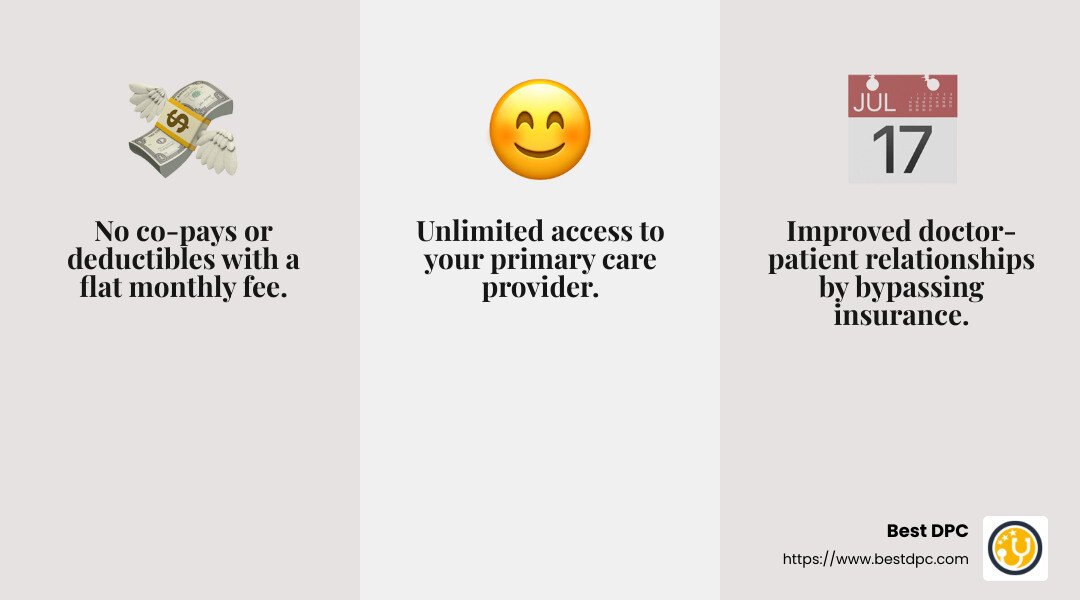Wayne Lowry

Health outcomes in direct primary care patients often outperform those in traditional healthcare settings. Patients experience:
Direct Primary Care (DPC) is revolutionizing the way healthcare is delivered. It’s a patient-centered health model that puts you in control. Patients pay a simple monthly fee for unlimited access to their doctor, skipping insurance headaches.
Imagine cutting out long wait times. Imagine avoiding surprise charges in the mail. With DPC, what you see is what you pay — clear, predictable, and stress-free.
A DPC model focuses on what matters most: your health. By fostering strong patient-doctor relationships, this approach ensures personalized attention. Routine check-ups to chronic condition management become easier and more effective.
If you’re tired of traditional healthcare hassles, exploring Direct Primary Care might be the solution. The benefits are clear, and the path to better health outcomes is within reach.

Understanding Direct Primary Care
Direct Primary Care (DPC) offers a fresh approach to healthcare with its subscription-based model. Patients pay a flat monthly fee directly to their doctor. This skips the usual insurance process and all the paperwork that comes with it.
Subscription-Based Model
In a DPC setup, you become a member of your doctor’s practice. This membership grants you unlimited access to your primary care provider. No more worrying about co-pays or deductibles. This model is simple and straightforward. You pay a set monthly fee, and in return, you receive comprehensive primary care services.
Flat Monthly Fee
The beauty of DPC is its financial transparency. With a flat monthly fee, you know exactly what you’re paying for. This fee covers most of your basic healthcare needs, such as routine check-ups, preventive care, and even some minor procedures. You won’t be hit with unexpected bills, making it easier to budget for healthcare.

Bypassing Insurance
One of the most appealing aspects of DPC is that it bypasses traditional insurance. This means no more dealing with insurance companies or worrying about claim denials. Without the need for insurance, doctors can focus more on patient care rather than administrative tasks. This leads to stronger doctor-patient relationships and better health outcomes.
DPC is about making healthcare accessible and straightforward. It puts patients first, offering a refreshing change from the complexities of traditional healthcare systems. If you’re looking for a healthcare model that prioritizes transparency, accessibility, and personalized care, Direct Primary Care might be just what you need.
Health Outcomes in Direct Primary Care Patients
Direct Primary Care (DPC) is revolutionizing how patients experience healthcare. By focusing on preventive care, chronic disease management, and personalized attention, DPC improves health outcomes significantly.
Improved Access and Patient Satisfaction
In DPC, patients enjoy improved access to their healthcare providers. They can schedule appointments quickly, often within a day, and spend more time with their doctors. This means less waiting and more talking, which builds trust and satisfaction.

Studies show that DPC patients have 25.5% lower hospital admissions. This is because doctors have more time to focus on prevention and early intervention. They can catch problems before they become serious, keeping patients healthier and out of the hospital.
Cost Savings and Financial Transparency
One of the biggest advantages of DPC is predictable costs. Patients pay a flat monthly fee for their care, which means no surprise bills. This transparency makes it easier to budget for healthcare expenses.
DPC also offers significant cost savings. By focusing on preventive care, patients can avoid expensive emergency room visits and specialist consultations. In fact, research shows that DPC can reduce the cost of ER claims by 53.6%.
Overall, DPC provides a more satisfying and cost-effective healthcare experience. Patients get the care they need when they need it, without the stress of unexpected costs. This model supports better health outcomes and a happier patient experience.
Benefits of Direct Primary Care for Providers
Direct Primary Care isn’t just beneficial for patients; it’s a game-changer for healthcare providers too. Let’s explore how DPC empowers providers through reduced administrative burdens, provider autonomy, and improved doctor-patient relationships.
Reduced Administrative Burdens
In traditional healthcare settings, doctors often spend more time on paperwork than with patients. This heavy administrative load can lead to burnout and dissatisfaction. But in DPC, the story is different.
DPC eliminates the need for insurance billing and coding. Providers can focus on what truly matters—patient care. This reduction in paperwork means less stress and more time for doctors to do what they love: helping people.

Provider Autonomy
With DPC, providers regain control over their practice. They decide how many patients to see and how much time to spend with each one. This autonomy allows for a more personalized approach to care.
Doctors can set their schedules, offer telemedicine, and tailor their services to meet patient needs. This flexibility leads to higher job satisfaction and better work-life balance. Providers can align their practice with their core values, creating a fulfilling work environment.
Improved Doctor-Patient Relationships
One of the most rewarding aspects of DPC is the strengthened relationship between doctors and patients. With more time available for each appointment, doctors can listen, understand, and connect with their patients. This builds trust and improves communication.
Patients feel heard and valued, leading to better health outcomes. When doctors know their patients well, they can provide more targeted and effective care. This deep connection is a key factor in the success of the DPC model.
At the end of the day, DPC offers significant benefits for providers. By reducing administrative burdens and enhancing autonomy, doctors can focus on their passion for patient care. This results in stronger doctor-patient relationships and a more satisfying practice for healthcare providers.
Next, we’ll dig into the Economic Implications of Direct Primary Care and how this model can contribute to lower healthcare costs and financial stability.
Economic Implications of Direct Primary Care
Direct Primary Care (DPC) isn’t just about better care for patients and happier doctors. It also makes economic sense. Let’s explore how DPC contributes to lower healthcare costs, a sustainable model, and financial stability.
Lower Healthcare Costs
DPC can significantly reduce healthcare expenses. Here’s how:
Sustainable Model
DPC practices are growing rapidly. In 2020, while traditional fee-for-service (FFS) practices saw revenue decline, DPC practices grew by 13%. This growth is fueled by:
Financial Stability
For both patients and providers, DPC offers financial stability:
In the next section, we’ll address some frequently asked questions about Direct Primary Care, including the health outcomes and benefits of this innovative model.
Frequently Asked Questions about Direct Primary Care
What are the health outcomes of primary care?
Direct Primary Care (DPC) leads to positive health outcomes by focusing on preventive care and chronic disease management. Patients benefit from early detection of health issues, which can prevent more serious conditions. For example, DPC members have 25% fewer hospital admissions, thanks to regular check-ups and monitoring.
Chronic disease management is another strength of DPC. With more time for each patient, physicians can create personalized plans that help manage conditions like diabetes or hypertension effectively. This approach not only improves health but also reduces the need for costly emergency interventions.
What are the benefits of direct patient care?
DPC offers several advantages over traditional healthcare models. One key benefit is personalized medicine. Patients receive care custom to their specific needs, which improves their overall health experience. With longer appointments, typically around 40 minutes, doctors can address multiple concerns and build stronger relationships with patients.
Preventive care is a cornerstone of DPC. Regular screenings and proactive health management help catch potential issues early. This focus on prevention leads to better long-term health outcomes and fewer medical emergencies.
DPC also provides comprehensive care. The flat monthly fee usually covers a wide range of services, from routine visits to minor procedures, ensuring that patients have access to necessary care without additional costs.
What are the disadvantages of DPC?
While DPC has many benefits, it’s important to consider its limitations. One potential downside is limited coverage. DPC typically focuses on primary care, so patients may need additional insurance for specialized care or hospitalizations.
Out-of-pocket costs can also be a concern. Although the monthly fee covers most primary care services, patients might still face expenses for services not included in the DPC plan, like imaging or specialist visits.
Finally, DPC might not be ideal for everyone. Patients with complex health needs requiring specialized care may find the model less suitable, as they’d need to coordinate and pay for those services separately.
In the next section, we’ll explore the benefits of Direct Primary Care for providers, highlighting how this model reduces administrative burdens and improves doctor-patient relationships.
Conclusion
Direct Primary Care (DPC) is reshaping healthcare by putting patients first. At Best DPC, the focus is on creating a patient-centered experience that emphasizes affordability, accessibility, and personalized care.
Affordability is a key advantage of DPC. Patients pay a flat monthly fee, which eliminates the surprise of unexpected medical bills. This financial transparency makes it easier for individuals and families to plan their healthcare budgets.
Accessibility is another major benefit. Patients enjoy quick access to their doctors, often within a day. This means less waiting and more time spent on what matters—your health. With personalized care, DPC physicians dedicate more time to each patient, allowing for comprehensive and custom healthcare plans.
At Best DPC, we believe in empowering patients through direct, open communication and a focus on preventative care. This approach not only improves health outcomes but also strengthens the doctor-patient relationship.
Explore how Best DPC can transform your healthcare experience. Find a network of compassionate providers dedicated to delivering patient-focused care.

ABOUT AUTHOR
Wayne Lowry
Wayne Lowry, Founder of BestDPC, is a passionate advocate for Direct Primary Care (DPC) and its mission to deliver personalized, accessible healthcare. He believes that DPC providers should serve as the trusted first point of contact for all medical needs, ensuring patients never feel isolated or uncertain about their health decisions. Through his work, he champions a patient-first approach to healthcare, building a system that prioritizes guidance, support, and trust.

Thank You for Registering!
Your registration was successful! We're excited to have you on board. Please check your email for a confirmation link to complete your registration.